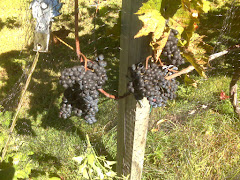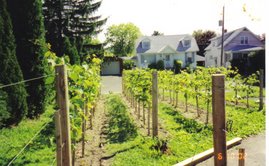 In planning my vineyard back in the year 2000, I knew something about wine making but nothing about what, if any grapes could be grown for wine making in the Capital District of New York State. I did a lot of research online and I looked to local vineyards for guidance. There were exactly one (1) vineyards growing wine grapes within an hour of my home. "This is not a good sign" I thought to myself. The next obvious question was, "why?" I was fortunate enough to stumble across the Cornell University website which just happens to include a plethora of viticultural information. This is due to the Finger Lakes AVA grape growing region. This AVA (American Viticultural Area) I found to be the most similar to the climate in my backyard. Using online historical weather databases, the information all said "you can't grow high quality wine grapes in your backyard." I guess that's why there was only one tiny little nothing of a commercial vineyard anywhere near my house. "Great, now what?" Because I was NOT about to give up on my plan for a home vineyard! So I read, and I read, and read some more. I went from having no idea what the difference was between the grape varieties used to make a French Bordeaux and a California Meritage. (there is no difference for the most part) I learned that most European wines are not named after the varietal that they are made form, while most new world wines are. I learned about the red varietals: Cabernet Sauvignon, Cabernet Franc, Merlot, Malbec, Syrah, Zinfandel/Primitivo, Sangiovese, Gamay, Pinot Noir, Petit Verdot, Tempranillo just to name a few. The white varitetals: Sauvignon Blanc, Chardonnay, Riesling, Viognier, Pinot Grigio, Pinot Blanc, Semillion, to scratch the surface. I had made wine from some of these varietals like Cabernet Sauvignon, Zinfandel and Merlot. I purchase these from a local distributor who imports California grapes every September. I had also come to appreciate many different commercial wines over the years. The conclusion that all the current knowledge had drawn me to though was this: Sadly, I could not grow the type of grapes I needed to make the types of wine that I love to drink. What and indescribable let down that was. You see, all the available expert advice coupled with the historical meteorological data said that Vitis Vinifera, the grape used to make the highest rated wines (ie; Cabernet Sauvignon, Sauvignon Blanc etc.) could not handle the climate in New York's Capital Region.
In planning my vineyard back in the year 2000, I knew something about wine making but nothing about what, if any grapes could be grown for wine making in the Capital District of New York State. I did a lot of research online and I looked to local vineyards for guidance. There were exactly one (1) vineyards growing wine grapes within an hour of my home. "This is not a good sign" I thought to myself. The next obvious question was, "why?" I was fortunate enough to stumble across the Cornell University website which just happens to include a plethora of viticultural information. This is due to the Finger Lakes AVA grape growing region. This AVA (American Viticultural Area) I found to be the most similar to the climate in my backyard. Using online historical weather databases, the information all said "you can't grow high quality wine grapes in your backyard." I guess that's why there was only one tiny little nothing of a commercial vineyard anywhere near my house. "Great, now what?" Because I was NOT about to give up on my plan for a home vineyard! So I read, and I read, and read some more. I went from having no idea what the difference was between the grape varieties used to make a French Bordeaux and a California Meritage. (there is no difference for the most part) I learned that most European wines are not named after the varietal that they are made form, while most new world wines are. I learned about the red varietals: Cabernet Sauvignon, Cabernet Franc, Merlot, Malbec, Syrah, Zinfandel/Primitivo, Sangiovese, Gamay, Pinot Noir, Petit Verdot, Tempranillo just to name a few. The white varitetals: Sauvignon Blanc, Chardonnay, Riesling, Viognier, Pinot Grigio, Pinot Blanc, Semillion, to scratch the surface. I had made wine from some of these varietals like Cabernet Sauvignon, Zinfandel and Merlot. I purchase these from a local distributor who imports California grapes every September. I had also come to appreciate many different commercial wines over the years. The conclusion that all the current knowledge had drawn me to though was this: Sadly, I could not grow the type of grapes I needed to make the types of wine that I love to drink. What and indescribable let down that was. You see, all the available expert advice coupled with the historical meteorological data said that Vitis Vinifera, the grape used to make the highest rated wines (ie; Cabernet Sauvignon, Sauvignon Blanc etc.) could not handle the climate in New York's Capital Region. I was crushed ( no pun intended), yet determined not to give up. Along the way, I had read about French-American Hybrids. These were exactly what their name implies; hybrids of Vitis Vinifera (wine grapes) and the cold hardy, disease resistant native American varieties, which make great jelly and juice, but terrible wine. Without going into way more detail than I already have, these varietals were created during the late 1800's in an effort to develop wine grapes that could resist the phylloxera root louse, an unintentionally imported American pest that pretty much wiped out all of France's vineyards at that time. These hybrids combined the natural phlloxera resistance of the American vines with the superior wine quality of the European vines. The problem was later resolved by grafting European vines onto American rooststocks. An unintentional feature of these hybrids though, was much hardier cold tolerance. You see Vitis Vinifera requires a long warm growing season and winter lows not colder than say 0 to -10 degrees Fahrenheit. I researched the record low in my area and found it to be -28 degrees Fahrenheit. Not good for me. This is where Cornell University came in to play. I learned about varieties like Chambourcin, Chancellor and Marechal Foch. These grapes could handle the cold, were planted widely in the Finger Lakes and Canada, and made into commercial wines.
 Next I went out to local wine stores and found these wines. I tasted and became depressed. I just didn't like them nearly as much as Cab's and Zin's. I tried really hard to like them cause I really wanted to grow wine grapes in my yard. The only one I seemed to be able get a little excited about was Marechal Foch. That, in a huge nutshell is was what led me to select it as one of the varieties I first planted. Every year so far, the grapes have ripened nicely and come in with good sugar and acid levels for wine making. The problem for me has been that if you try to make wine with these grapes like you would make Cabernet Sauvinon or other vinifera grapes, it tastes funky. So I have spent the past 5 years trying to figure out how to make the best wine possible with these grapes and I think this year may be the year. It really helps that the weather was great and the fruit that came in from my Foch vines was just perfect as the above pictures show. For you winemakers here are the harvest details:
Next I went out to local wine stores and found these wines. I tasted and became depressed. I just didn't like them nearly as much as Cab's and Zin's. I tried really hard to like them cause I really wanted to grow wine grapes in my yard. The only one I seemed to be able get a little excited about was Marechal Foch. That, in a huge nutshell is was what led me to select it as one of the varieties I first planted. Every year so far, the grapes have ripened nicely and come in with good sugar and acid levels for wine making. The problem for me has been that if you try to make wine with these grapes like you would make Cabernet Sauvinon or other vinifera grapes, it tastes funky. So I have spent the past 5 years trying to figure out how to make the best wine possible with these grapes and I think this year may be the year. It really helps that the weather was great and the fruit that came in from my Foch vines was just perfect as the above pictures show. For you winemakers here are the harvest details:Harvest Date: 9/26/2007
Brix: 24.2
TA: .6
PH: 3.59
These numbers coupled with the taste and condition of the fruit, have me very excited about the wine potential. So far the early results are super promising. I'll keep you posted along the way.

















